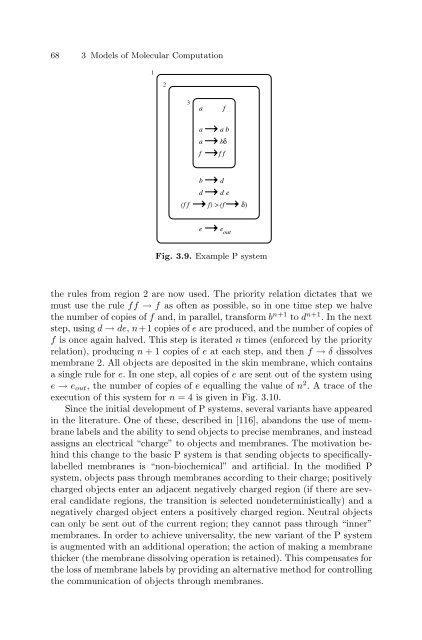Theoretical and Experimental DNA Computation (Natural ...
Theoretical and Experimental DNA Computation (Natural ...
Theoretical and Experimental DNA Computation (Natural ...
Create successful ePaper yourself
Turn your PDF publications into a flip-book with our unique Google optimized e-Paper software.
68 3 Models of Molecular <strong>Computation</strong><br />
1<br />
2<br />
3<br />
(f f<br />
a f<br />
a<br />
a<br />
a b<br />
b δ<br />
f f f<br />
b d<br />
d de<br />
f) > (f δ)<br />
e e out<br />
Fig. 3.9. Example P system<br />
the rules from region 2 are now used. The priority relation dictates that we<br />
must use the rule ff → f as often as possible, so in one time step we halve<br />
the number of copies of f <strong>and</strong>, in parallel, transform b n+1 to d n+1 . In the next<br />
step, using d → de, n+1 copies of e are produced, <strong>and</strong> the number of copies of<br />
f is once again halved. This step is iterated n times (enforced by the priority<br />
relation), producing n + 1 copies of e at each step, <strong>and</strong> then f → δ dissolves<br />
membrane 2. All objects are deposited in the skin membrane, which contains<br />
a single rule for e. In one step, all copies of e are sent out of the system using<br />
e → eout, the number of copies of e equalling the value of n 2 .Atraceofthe<br />
execution of this system for n = 4 is given in Fig. 3.10.<br />
Since the initial development of P systems, several variants have appeared<br />
in the literature. One of these, described in [116], ab<strong>and</strong>ons the use of membrane<br />
labels <strong>and</strong> the ability to send objects to precise membranes, <strong>and</strong> instead<br />
assigns an electrical “charge” to objects <strong>and</strong> membranes. The motivation behind<br />
this change to the basic P system is that sending objects to specificallylabelled<br />
membranes is “non-biochemical” <strong>and</strong> artificial. In the modified P<br />
system, objects pass through membranes according to their charge; positively<br />
charged objects enter an adjacent negatively charged region (if there are several<br />
c<strong>and</strong>idate regions, the transition is selected nondeterministically) <strong>and</strong> a<br />
negatively charged object enters a positively charged region. Neutral objects<br />
can only be sent out of the current region; they cannot pass through “inner”<br />
membranes. In order to achieve universality, the new variant of the P system<br />
is augmented with an additional operation; the action of making a membrane<br />
thicker (the membrane dissolving operation is retained). This compensates for<br />
the loss of membrane labels by providing an alternative method for controlling<br />
the communication of objects through membranes.







